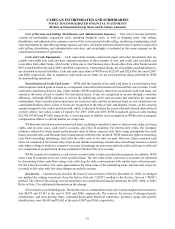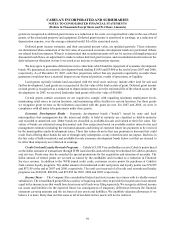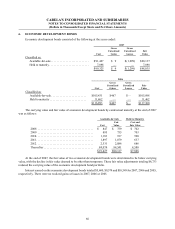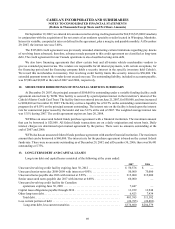Cabela's 2007 Annual Report Download - page 66
Download and view the complete annual report
Please find page 66 of the 2007 Cabela's annual report below. You can navigate through the pages in the report by either clicking on the pages listed below, or by using the keyword search tool below to find specific information within the annual report.
60
CABELA’S INCORPORATED AND SUBSIDIARIES
NOTES TO CONSOLIDATED FINANCIAL STATEMENTS
(Dollars in Thousands Except Share and Per Share Amounts)
Stock-Based Compensation – We adopted the provisions of FAS No. 123 (revised 2004), Share-Based
Payment (“FAS 123R”), on January 1, 2006, using the modified prospective transition method. Prior to January 1,
2006, we accounted for stock-based payments under the provisions of Accounting Principles Board (“APB”) Opinion
No. 25, Accounting for Stock Issued to Employees, and related interpretations. Effective January 1, 2006, we also
adopted FASB Staff Interpretation FAS 123(R)-3, Transition Election Related to Accounting for the Tax Effect of
Share-Based Payment Awards, relating to transitional guidance on determining and reporting excess tax benefits
from stock options exercised.
Under FAS 123R, we recognize compensation expense as follows. For equity awards issued after January 1,
2006, compensation expense is estimated based on grant date fair value on a straight-line basis over the requisite
service period. For awards granted prior to, but not yet vested as of January 1, 2006, we estimated compensation
expense based on the grant date fair value estimated under the provisions of APB Opinion No. 25. Costs associated
with all awards are included in compensation expense as a component of selling, distribution, and administrative
expenses.
Financial Instruments and Credit Risk Concentrations – Financial instruments which may subject us to
concentrations of credit risk are primarily cash, investments, and accounts receivable. We invest primarily in money
market accounts, tax-free municipal bonds, or commercial paper, with short-term maturities, limiting the amount of
credit exposure to any one entity. Concentrations of credit risk on accounts receivable are limited due to the nature
of our receivables.
Fair Value of Financial Instruments – The carrying amount of cash and cash equivalents, receivables, credit
card loans held for sale, retained interests in asset securitizations, accounts payable, short-term borrowings, notes
payable to banks, and accrued expenses approximate fair value because of the short maturity of these instruments.
The fair values of our long-term debt instruments are based on the amount of future cash flows associated with each
instrument discounted using current borrowing rates for similar debt instruments of comparable maturity. Time
deposits are pooled in homogeneous groups, and the future cash flows of those groups are discounted using current
market rates offered for similar products for purposes of estimating fair value.
Derivatives – We use derivatives for the purpose of hedging our exposure to changes in interest rates and
foreign currency exchange rates. The fair value of each derivative is recognized in the consolidated balance sheets
within current assets or current liabilities. For derivatives designated as a hedge and used to hedge an anticipated
transaction, changes in the fair value of the derivatives are deferred in the consolidated balance sheets within
accumulated other comprehensive income (loss) to the extent the hedge is effective in mitigating the exposure to the
related anticipated transaction. Any ineffectiveness associated with the hedge is recognized immediately in earnings.
Amounts deferred within accumulated other comprehensive income (loss) are recognized in the consolidated income
statements in the same period during which the hedged transaction affects earnings. For derivatives that do not
qualify for hedge accounting, changes in fair values are recognized immediately in earnings.
Comprehensive Income – Comprehensive income consists of net income, derivative adjustments, unrealized
gains and losses on available-for-sale economic development bonds, and foreign currency translation adjustments,
net of related income taxes.
Currency Translation – Assets and liabilities of our Canadian operations are translated into U. S. dollars at
currency exchange rates in effect at the end of a reporting period. Gains and losses from translation into U. S. dollars
are included in accumulated other comprehensive income (loss) in our consolidated balance sheets. Revenues and
expenses are translated at average monthly currency exchange rates.
Earnings Per Share – Basic earnings per share (“EPS”) is computed by dividing net income by the weighted
average number of shares of common stock outstanding during the period. Diluted EPS is computed by dividing net
income by the sum of the weighted average number of shares outstanding plus all additional common shares that
would have been outstanding if potentially dilutive common share equivalents had been issued. Options exercised
prior to vesting for 2006 and 2005 have not been considered in the basic EPS calculation, but are considered in the
computation of diluted EPS.
























